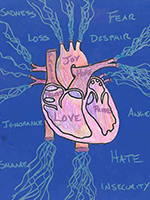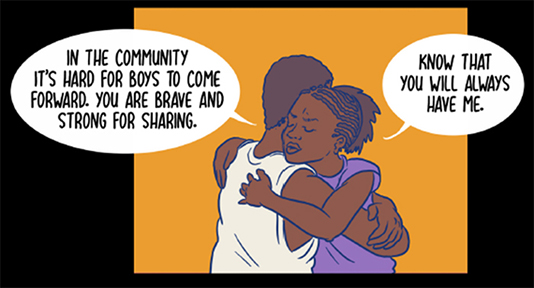Meet the Methods Series: Arts-Based Methods for Illuminating Gender in Community-Based Research
Issue 5 – May 2022

Ph.D.
Carmen Logie, Ph.D., is a Canada Research Chair in Global Health Equity and Social Justice with Marginalized Populations and Associate Professor at the University of Toronto’s Factor-Inwentash Faculty of Social Work. Her research focuses on interventions to address intersectional stigma and other social ecological factors associated with HIV and sexually transmitted infection prevention and care. She is also the host of “Everybody Hates Me: Let’s Talk About Stigma,” a podcast which features stigma experts from around the world. In this issue, we spoke with Carmen Logie about how arts-based methods can be leveraged to explore gender in community-based health research.
What are arts-based methods?
Arts-based methods use creative modes of expression to examine lived experiences. Art can be the focus of the research. For example, in photo-elicitation, researchers show photos to participants, who then reflect on the meaning this art has to them. Art can also be part of the research process. For instance, in photovoice, participants take photos related to a research topic to share what is meaningful to them. Arts-based approaches can serve as interventions and be integrated into trainings.
Some arts-based methods which have been around for a long time haven’t necessarily been integrated into health research. For example, graphic medicine (the use of comics in medical education and patient care) has been around for decades, but there is only a small body of research on the use of comics as health interventions. In this way, older methods can be implemented in fresh ways, and innovative arts-based approaches can particularly resonate with younger participants.
It’s also important to balance new, emerging technologies with what is accessible. For example, for photovoice, not everyone has a smartphone or access to somewhere they can print photos, and so a Polaroid-style camera could be more accessible.
Case Study: Gendered Perspectives Revealed Through Photovoice
Displaced youth in Haiti generated data using photovoice to identify barriers to HIV prevention engagement. Participants’ photos reflected gender norms and power dynamics that shape sexual health. For instance, some adolescent boys and young men took photos of themselves working, illustrating concerns about unemployment and political instability affecting their ability to provide for their families and the women in their lives, whereas several adolescent girls and young women photographed tents at the Internally Displaced Persons camp, re-enacting their lack of safety and experiences of sexual violenceFootnote 1.
Why should health researchers consider using arts-based methods?
- When provided with opportunities for self-expression and creation, participants may share insights that you hadn’t thought to ask about. This shift empowers participants to control the narration and interpretation of their own stories and intersectional experiences.Footnote 2
- They’re fun, engaging, and provide a powerful way of talking about challenging topics. Instead of participants sitting in front of a researcher and answering questions about their emotions, health practices, and painful experiences, they can shift their focus inwards and focus on creatively expressing how they feel.
- They can move us, stir up our emotions, and build empathy, which can help produce social change through a feeling of common humanity between research participants and the public, policymakers, and health care providers.
- Art can be long-lasting. The art created throughout the research process can serve as knowledge mobilization products long after the research is complete.
What steps should researchers who are considering using arts-based methods take?
- Talk to the communities you’re working with to see what kind of methods they’re excited about, and perhaps already using.
- Research the history of the method, and how it may have been used to advance social change.
- Come back to the community with what you’ve learned, share ideas, and engage in an iterative and flexible process to design the study. Repeat steps 1 to 3 as necessary.
Case Study: Forum Theatre and Empowerment Narratives
Forum theatre (or participatory theatre) is rooted in the Theatre of the Oppressed, a theatrical form developed in Brazil by Augusto Boal in the 1970s.Footnote 3Footnote 4 Boal used theatre to push for social change by empowering spectators to become “spect-actors” who could enact their own endings or solutions. Theatre was also used in AIDS activism in the early 1980s to challenge intersecting LGBTQIA/2S stigma and HIV stigma.Footnote 5 This method continues to be relevant to health research today. For instance, participatory theatre was used to reduce community and healthcare stigma towards LGBTQ persons in Eswatini and Lesotho and to build solidarity among sexually and gender diverse personsFootnote 6.

-
Long description
A cartoon illustration representing the anatomy of a human heart, with many types of emotions listed on and around the heart. On the heart are the words love, joy, trust, pride, hope, passion. Around the heart are listed fear, despair, anger, hate, insecurity, shame, ignorance, loss and sadness.
Case Study: Body Mapping and the Focus on Trans Women’s Bodies
Body mapping is used for self-reflection, therapy, and research. Individuals create and annotate artistic renditions of their bodies through drawing, painting, and other arts-based techniquesFootnote 7.
In the TRANScending Love study, body mapping was suggested as an arts-based stigma intervention with trans women of colour. However, consultation participants expressed concerns that this approach could be triggering due to its focus on the physical body. Three new activities were then co-developed with community leaders: 1) heart mapping: participants wrote and illustrated their emotions and coping strategies on anatomical drawings of hearts; 2) hand-held mirrors with glass markers: participants reflected on their own strengths and wrote messages of self-love; and 3) blank affirmation cards: participants wrote supportive messages to other trans women.Footnote 8Footnote 9
What are your tips for community-based researchers, regardless of the methods they’re using?
- Challenge the belief that some communities are “hard to reach.” This label is often attached to communities, but not to researchers. Consider flipping the script and asking why you as a researcher may be hard to reach. What can you do to build relationships and design research that is exciting, fun, and comfortable for participants to engage in? Check out Carmen Logie’s book, “Working with Excluded Populations in HIV: Hard to Reach or Out of Sight”Footnote 10to learn more.
- Put yourself in the position that you’re asking participants to be in. Try the activities or interventions yourself before asking participants to engage with them. This step will help you understand the vulnerability required to participate, and gauge whether your proposed activities are engaging.
Case Study: Participatory Comics as Gender-Transformative Interventions
Participatory comics are a low-cost, youth-friendly, and scalable way to increase health promotion and literacy. Survivor-informed comic books were used to advance sexual and gender-based violence prevention and care among refugee youth in Uganda. Comic scenarios were informed by the narratives of refugee youth, elders, and healthcare providers. Participants were presented with blank panels to fill out as they reflected on their experiences and created solutions.
For example, panels challenged harmful gender norms by exploring how men could be active members of anti-violence initiatives, addressing inequitable gender norms around forced and early marriage expectations, and challenging gendered and stigmatizing beliefs about sexual violence survivors. The comic book approach motivated youth to participate in the study, with participants even requesting extra copies of the comics to share with friends.Footnote 11

-
Long description
A cartoon illustration depicting two people hugging. The person on the left is expressing their feelings and the other person is being supportive. The text on the left reads: “In the community, it’s hard for boys to come forward. You are brave and strong for sharing”. The text on the right reads: “Know that you will always have me”.
The views expressed in this document are those of Carmen Logie and do not necessarily reflect those of the CIHR Institute of Gender and Health or the Government of Canada.
- Date modified: